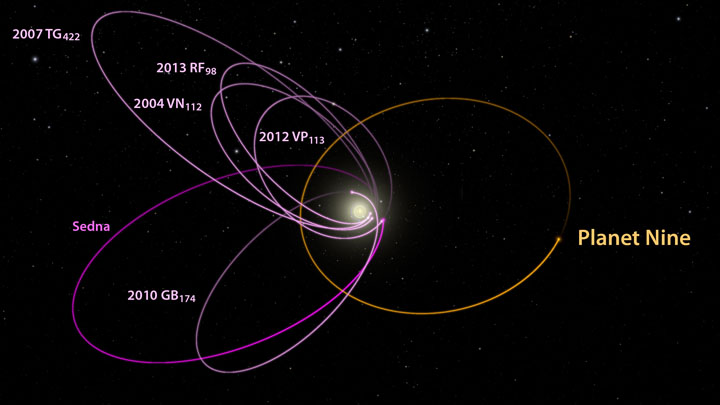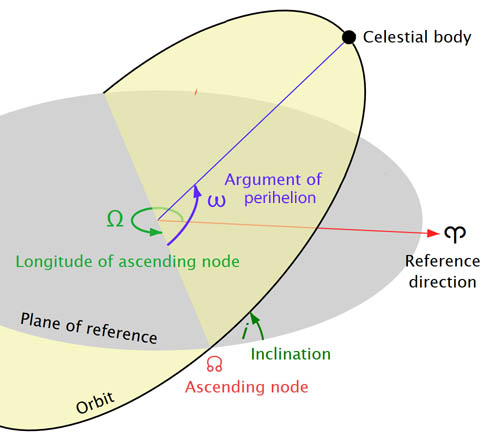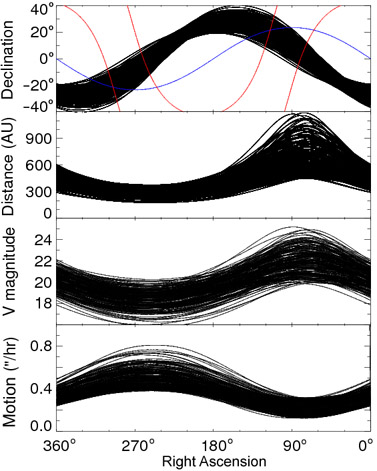Are astronomers being misled by the quirky alignment of orbits that they’re finding in the distant Kuiper Belt?
Even as the count of known planets around other stars continues to climb, a small group of observational astronomers and dynamicists are fixated on something much closer to home: tantalizing clues that a super-Earth-size planet lurks undiscovered somewhere beyond the Kuiper Belt in our own solar system.
Some have dubbed it "Planet X," others "Planet 9," and right now observing teams are using some of the world’s largest telescopes in a race to track it down. One big problem is that they’re not sure where to look — or if it even exists.

Caltech / Robert Hurt
The evidence so far is purely circumstantial. To recap, observers have started to accumulate discoveries of a class of far-flung objects in a kind of dynamical "no man's land." They have very eccentric orbits that average at least 150 astronomical units from the Sun (five times Neptune’s distance) but never come closer to the Sun than Neptune’s 30 a.u.

Lasunncty / Wikipedia / CC BY-SA 3.0
Chadwick Trujillo (then at Gemini Observatory) and Scott Sheppard (Carnegie Institution for Science) were the first to realize that the initial 12 such discoveries all had perihelia, the point of their orbits closest to the Sun, near the ecliptic plane (the argument of perihelion for each was near 0° or 180°). Although they initially thought this arrangement might be due to a distant, massive planet, an analysis last year by Ann-Marie Madigan (University of California, Berkeley) and Michael McCourt (Harvard University) concluded that one big planet wouldn’t do — but that a massive disk of Kuiper Belt objects in eccentric orbits would.
Meanwhile, Konstantin Batygin and Michael Brown (Caltech) realized that the longitude of these perihelia also cluster on one side of the Sun. Such an alignment wouldn’t happen by chance: The elongated orbits of these objects should gradually precess (pivot) around the Sun at different rates, so the current convergence ought to fall apart in perhaps 10 million years, a short time compared to the age of the solar system. But a single, massive planet — itself in a highly eccentric orbit — could impose the observed orbital order via subtle, long-term gravitational perturbations.
Are the Observations Biased?
All along, the nagging question has been whether a sample of just a dozen objects, however tightly their orbits might be clustered, is enough to make a robust statistical case for a massive unseen planet. Is their orbital congregation real, or is it just a quirk outcome due to how observers searched for them? Two recent analyses offer opposing answers to this crucial question.
A team led by Cory Shankman (University of Victoria, Canada) argues that observational bias is skewing our perception of reality. Made public on June 18th and due to appear in the Astronomical Journal, the analysis details how the Outer Solar System Origins Survey discovered (beginning in 2013) eight new Kuiper Belt objects that are on average at least 150 a.u. from the Sun and never come closer than 30 a.u. One find, 2013 SY99, ranges in its solar distance from 50 a.u. to an incredible 1,420 a.u.
At face value, some of these eight objects have orbits roughly aligned with the dozen earlier finds, but others do not. More importantly, simulations of the project’s observing strategy suggest that “the orbital distribution in the OSSOS sample could have resulted from a randomly oriented population of objects — it doesn’t require the clustering that others have claimed.” More broadly, Shankman and his colleagues argue that the apparent clustering is an artifact of how these challenging observations — by OSSOS and others — are being made.
First, because these objects have such strongly elongated orbits, they’re far more likely to be discovered when close in (near perihelion). And if observers consistently look for them along the ecliptic or far from the congested plane of the Milky Way, as has often been the case, then the outcome is a cluster of objects in these preferred directions. The OSSOS team acknowledges this observational bias and concludes it could have preferentially swept up objects from an otherwise random distribution that have orbital characteristics.
But does that logic apply to the clustering reported by Trujillo/Sheppard and Batygin/Brown? In an analysis posted just last week as well, Brown concludes that observational bias can’t explain the clustering of the original 12 distant, eccentric KBOs. "Shankman [and colleagues] make the unwarranted conclusion that 'If our survey is biased, everyone else's must be too,'" says Brown.

Konstantin Batygin & Mike Brown
"[The OSSOS survey] was done at only a few longitudinal locations, which makes it hard to say much about the areas they didn’t survey," Sheppard says. Still, he adds, "It’s great that more extreme objects are being found," because up to this point everyone has been grappling with statistical probabilities based on a very limited sample.
One sure way to end all the speculation, of course, would be to find this hypothesized planet. Batygin and Brown estimate that it must have at least 10 times Earth's mass and be a few times bigger around. But their simulations say it also needs to be in a highly elongated orbit that averages maybe 700 a.u. (100 billion kilometers) from the Sun. In that kind of orbit, it’s going to spend most of its 10,000- to 20,000-year orbital period very far from perihelion. Maybe it’s no brighter than magnitude 22 — a challenge to spot even in the best telescopes.
So both Brown and Trujillo/Sheppard will be looking in the months ahead, and both are using the 8.2-meter Subaru Telescope on Mauna Kea. "Either we will find it, or we will not," Brown says. "My money is still on finding it."
Evidence for Another Kuiper Belt "Planet"
Meanwhile, a third analysis of distant orbits also argues that the Kuiper Belt harbors a planet, though this one isn’t nearly so massive or far away.
Kathyrn Volk and Renu Malhotra (University of Arizona) analyzed the orbits of more than 600 Kuiper Belt objects and found that those that orbit relatively close-in have orientations that, collectively, match the average plane of our planetary system (known as the invariable plane) to within 2°.
However, more distant ones, those averaging 50 to 80 a.u. from the Sun, deviate from the invariable plane by roughly 9° and create a kind of warp in the overall distribution of orbits. "There is not more than a 1% or 2% chance that this warp is merely a statistical fluke," Volk points out. Instead, she and Malhotra suspect that the warp is due to something at least as massive as Mars situated roughly 60 a.u. from the Sun in an orbit 8° inclined to the plane.

Univ. of Arizona / Heather Roper
So wouldn’t such a body have been spotted by now? Maybe not. As Volk notes in a university press release, there’s a 30% chance that Kuiper Belt surveys to date would have overlooked an object of the right brightness and distance. If it really exists, the Large Synoptic Survey Telescope should sweep it up quickly once it starts scouring the sky in a few years.
 3
3









Comments
ludwig
June 23, 2017 at 5:29 pm
It is logical, according to Bode's Law (maybe should be called" theory'?) that there is or should be a planet there that we cannot find or see --IF it exists.
IT is easy to say well it is there but it is 2000 light years away in its perhilion and its apogee or aperhillion is also 2000 light years so that is why just cannot find it but the truth maybe is that Bode's planet numerology 'law' is wrong and if not then perhaps the hypothetical solution is that the missing planet is now a moon that was knocked into its present orbit thus as becoming a satellite of Jupiter, Neptune or Uranus or an asteroid. That could be why we cannot see the forest for the trees?
You must be logged in to post a comment.
Peter Wilson
June 27, 2017 at 12:46 pm
Bode's "law" is an empirical observation that ends with Uranus. Since Neptune does not fit the pattern, there is no reason to expect it beyond Neptune.
You must be logged in to post a comment.
Nistar
October 28, 2017 at 9:36 pm
I know you are all very logical and the Astronomer in Cali has a formula just for question sake. Which direction is he/you looking towards state constellation name area?
If by chance you're looking towards Pisces I would like to know? I this is the case then I may have an answer worth pursuing.
Thank you for your time please let me know as soon as possible, please.
Cordially, Nistar
You must be logged in to post a comment.
You must be logged in to post a comment.